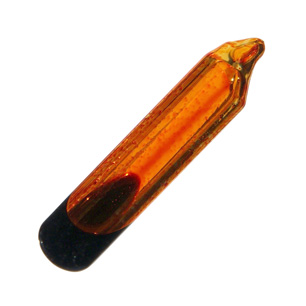Bromides and Bromine

Pure liquid bromine.
Bromine is a chemical element of the halogen group, which includes fluorine, chlorine, iodine and astatine. Bromide is an anion of bromine, commonly found in trace amounts as salt in sea-water, along with sodium chloride (common table salt). Humans are often exposed to bromide through foods, including nuts, grains and sea-food. Bromide compounds, notably sodium bromide, were once used as sedatives and in the treatment of convulsions.
Bromine can bond with carbon to form organic compounds known as organobromines. These are used for soil fumigation (methyl bromide, also known as bromomethane), flame retardants (polybrominated diphenyl ethers), lead-scavanging agents in fuels (ethylene dibromide, also known as 1,2-Dibromoethane), in pharmaceuticals, and as water disinfectants.
Although it is not typically a water treatment concern on its own, small amounts of bromide can be involved in chemical reactions that produce undesirable byproducts, during water chlorination (trihalomethanes, haloacetic acids) or ozonation (bromate).
Health Effects of Bromide
Bromide is of low acute toxicity. The World Health Organization reports that it may even have some benefit to human health: limited studies have shown a link between bromide deficiencies and insomnia in hemodialysis patients.
Large amounts of bromide can cause poisoning, with symptoms including nausea, vomiting, abdominal pain, coma and paralysis. Chronic exposure to bromide can cause bromism, a condition with symptoms including neurological effects (restlessness, irritability, ataxia, confusion, hallucinations, psychosis, weakness, stupor, and coma), skin rashes and gastrointestinal problems.
Water Treatment for Bromide
Bromide may be treated with reverse osmosis, with a removal rate of around 95%. It can also treated with activated carbon, ultrafiltration, and dialysis.
Sources: WHO, Wikipedia: Bromine, Wikipedia: Bromide, Wikipedia: Organobromine Compound, EPA, Photo: images-of-elements.com
Site Index
Filtration Systems
- Aeration for Iron & Sulfide
- Backwashing Filters
(whole house & well units)
- Chlorine & Chemical Injectors
- Countertop Water Filters
- Garden Hose Filters
- Reverse Osmosis, Residential
- Reverse Osmosis, Commercial
- Shower Filters
- Specialty Filters
- Ultraviolet Systems
- Undersink Filters
- Water Softeners
- Whole House Filters
Cartridges
Parts
- Replacement Parts
- Faucets
- Filter Media
- Fittings
- Housings
- O-rings
- Pumps
- Pura UV
- R.O. Parts
- R.O. Tanks
- R.O. Booster Pump
- VIQUA UV